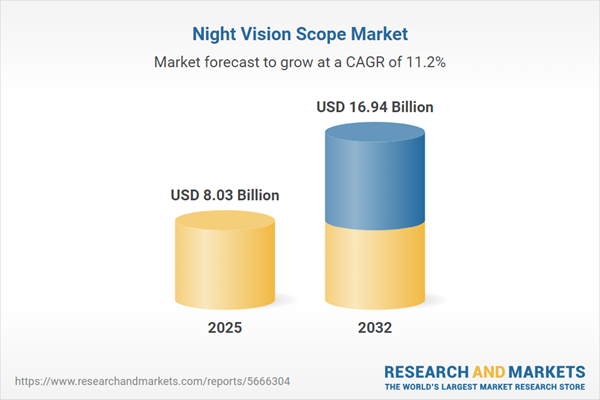Speak directly to the analyst to clarify any post sales queries you may have.
Amid transformative shifts in defense, law enforcement, and optical technology, the night vision scope market demands strategic realignment from senior leaders navigating evolving operational frameworks and regulatory landscapes. This report delivers focused, actionable intelligence to help organizations optimize procurement decisions and sustain operational readiness.
Market Snapshot: Trends in the Night Vision Scope Market
The night vision scope market is experiencing notable growth, propelled by sustained defense investment and imaging technology advancements. Military, law enforcement, and commercial end users are transitioning from analog to digital night vision systems, resulting in greater demand for operational adaptability and enhanced tactical performance. Key trends reshaping the competitive landscape include increased use of modular optics for custom field configurations, real-time analytics to bolster incident response, and heightened prioritization of seamless device connectivity. While steady technological progress drives adoption, regional shifts in regulations add complexity, compelling market players to implement agile response strategies to uphold their position amid amplified segmentation and evolving compliance standards.
Scope & Segmentation of the Night Vision Scope Market
This executive report provides targeted, segment-specific insights designed for procurement, compliance, and strategy leaders assessing the night vision scope market.
- Platform: Encompasses binoculars, monoculars, helmet-mounted systems, UAV-based solutions, rifle scopes, and spotting optics, each engineered to support tactical, reconnaissance, and surveillance operations across multiple use-case environments.
- Technology Type: Details include digital night vision, image intensifier tubes, and thermal imaging systems, each adapted for differing operational and mission-specific requirements in dynamic field settings.
- Generation Category: Covers Gen 1 to Gen 4 night vision technologies, offering clarity on system endurance, longevity, and adaptability in mission-critical scenarios.
- Application: Spans a wide range of uses such as hunting, security protocols, continuous surveillance, wildlife observation, and both law enforcement and military deployment, relevant to diverse industry verticals.
- End User: Compares the distinct requirements of military, civilian, and law enforcement sectors, reflecting differentiated compliance and operational expectations.
- Distribution Channel: Examines online and offline procurement avenues, highlighting the accessibility preferences of user groups and variations by geographic locale.
- Region: Assesses regulatory influence and technology drivers in the Americas, Europe, Middle East, Africa, and Asia-Pacific, providing strategic region-specific guidance for market participants.
- Leading Companies: Profiles major providers, including BAE Systems plc, L3Harris Technologies, Inc., Northrop Grumman Corporation, Leonardo S.p.A., Thales S.A., Teledyne Technologies, Inc., Elbit Systems Ltd., Safran S.A., Rheinmetall AG, and Opgal Optronics Industries Ltd., outlining their technical strengths and approaches to sectoral support.
Key Takeaways for Strategic Decision-Makers
- Hybrid analog and digital systems promote adaptable field operations, expanding suitability for varied operational contexts and mission profiles.
- Modular architectures provide quick adaptability, simplifying transitions between different deployment scenarios and enabling tailored operational solutions.
- Machine learning-driven analytics significantly improve situational awareness by supporting faster, more informed responses to developing incidents.
- Prioritizing lifecycle management and structured upgrade planning ensures sustained operational value and minimizes exposure to emerging technology risks.
- Procurement practices vary by geography, influencing supplier engagement—established partner networks in North America, system integrators in Europe and the Middle East, and digital procurement channels in Asia-Pacific affect access and distribution.
- A diverse ecosystem of solution providers fosters custom product development aligned to the operational needs of each user segment, driving greater alignment with mission demands.
Tariff Impact: Responding to Regulatory and Supply Chain Changes
Recent tariff policy changes in the United States are causing organizations to reevaluate supplier relationships and procurement practices within the night vision scope supply chain. There is heightened emphasis on local sourcing strategies and the integration of energy-efficient product designs to ensure ongoing compliance and reduce operational risk. These shifts enhance resilience by supporting continuous product availability and mitigating the effects of evolving regulatory and trade environments.
Methodology & Data Sources
This report’s findings are built on expert interviews, comprehensive literature analyses, and rigorous data triangulation. Technical benchmarking and comparative assessment methods underpin conclusions, ensuring credible guidance for procurement, financial planning, and market-entry strategies.
Why This Night Vision Scope Market Report Matters
- Empowers leaders with clear intelligence for navigating changes in regulatory, technology, and distribution domains across the night vision scope industry.
- Enables robust contingency planning and supply chain risk management to support continuous readiness and adaptability.
- Delivers practical, actionable insights on systems innovation, integration, and strategic planning across diverse operational and compliance environments.
Conclusion
This report equips senior stakeholders with targeted, real-world insights to refine strategies, allocate technology investments, and sustain operational leadership in the continually evolving night vision scope sector.
Additional Product Information:
- Purchase of this report includes 1 year online access with quarterly updates.
- This report can be updated on request. Please contact our Customer Experience team using the Ask a Question widget on our website.
Table of Contents
3. Executive Summary
4. Market Overview
7. Cumulative Impact of Artificial Intelligence 2025
List of Figures
Companies Mentioned
The companies profiled in this Night Vision Scope market report include:- BAE Systems PLC
- L3Harris Technologies, Inc.
- Northrop Grumman Corporation
- Leonardo S.p.A.
- Thales S.A.
- Teledyne Technologies, Inc.
- Elbit Systems Ltd.
- Safran S.A.
- Rheinmetall AG
- Opgal Optronics Industries Ltd.
Table Information
| Report Attribute | Details |
|---|---|
| No. of Pages | 184 |
| Published | November 2025 |
| Forecast Period | 2025 - 2032 |
| Estimated Market Value ( USD | $ 8.03 Billion |
| Forecasted Market Value ( USD | $ 16.94 Billion |
| Compound Annual Growth Rate | 11.2% |
| Regions Covered | Global |
| No. of Companies Mentioned | 11 |









